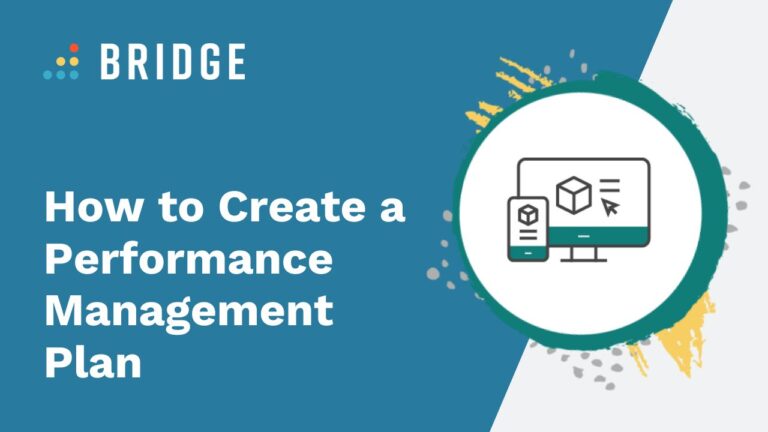Discover how to plan and enact an effective performance management program, align your people with organizational objectives, and foster a culture of continuous growth.
Successful performance management isn’t just a formality—it’s a continuous process of aligning goals, tracking progress, and developing people to power the full potential of your workforce.
According to the findings from Bridge’s report in partnership with HR Research Institute, organizations that excel in performance management are nearly four times more likely to engage in regular performance conversations.
Responses from HR professionals also reveal that these same organizations are three times as likely to track conversations and 1.5 times more likely to embrace a structured and continuous performance management approach.
An effective plan for evaluating employee achievements, driving professional growth, and aligning individual goals with the company’s strategic vision is key to achieving this success.
The Importance of a Performance Management Plan
Performance management is an ongoing cycle of setting expectations, tracking progress, and providing feedback to drive overall organizational goals.
A performance management plan is a structured and systematic way for HR and talent management teams to plan, track, and align performance goals with the wider business.
A successful plan will typically encompass several components, all of which will outline and share the steps, activities, and milestones in your performance program, including:
- Goal setting
- Continuous feedback
- Performance reviews
- Training and development
- Rewards and recognition
Together, these elements work to create a more holistic and agile process.
Here are the necessary steps to consider when creating a yearly performance management plan:
1) Well-Defined Performance Objectives
To formulate strategic initiatives for the performance cycle ahead, look at existing processes and results. From here, you can determine what success looks like to your organization and how to get there. This should involve:
Cultivating an Understanding of Business Plans and Priorities
Start at the top with the mission, vision, and strategy described by leaders and execs that define performance goals and objectives.
A clear understanding of your organization's strategic goals and upcoming plans is critical—this is the basis for building employee and team goals and communicating the vision and timeframe for these objectives.
Gathering Employee Feedback
Your people are an invaluable source of information, and opening channels of communication via an engagement survey can reveal a depth of information about the effectiveness of your performance management processes.
By bringing your people into the performance planning process, you establish a clear benchmark for metrics such as engagement and productivity that you can track over time.
It's also an effective way to uncover areas for improvement that analytics alone might not capture and encourage ownership over personal and professional goals.
INFORM YOUR NEXT SURVEY WITH THESE QUESTIONS | ‘30 Employee Engagement Questions You Need to Ask in Your Next Survey’
Establishing a Clear Competency Framework
Employees want to know how they're progressing, and a clear competency framework can make performance progress easier to measure and assess. In fact, Gartner research shows that when organizations translate high performance into a series of clear behaviors and use these defined competencies to recognize employees for their achievements in real time, they're almost six times more likely to deliver optimal outcomes.
Define the behaviors and competencies used to measure success during the performance cycle. This information should be documented and communicated with people so they understand the activities and attitudes that guide what they do.
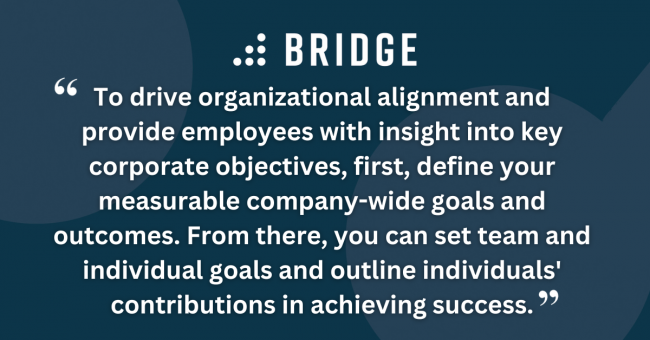
2) Firmly Established Goal-Setting Processes
Setting expectations for managers and employees and establishing realistic goals is an integral stage of the performance management cycle. You must account for several factors to ensure all goals are relevant and personalized and that managers and employees are confident they can achieve them. Consider the following:
Using the SMARTER Framework When Setting Goals
SMARTER goals set the expectation for performance outcomes and results with clear parameters, making goals easier to track and evaluate. Be sure that each goal sticks to the following structure:
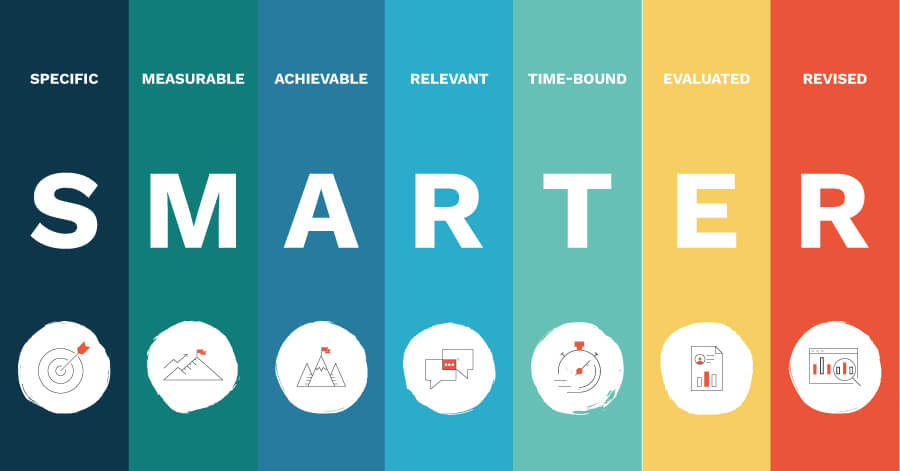
Specific: Make it clear exactly what actions, results, or outcomes are expected.
Measurable: Where possible, use quantifiable measures such as percentages, ratios, or direct counts.
Achievable: Keep goals realistic and attainable while creating opportunities for challenge and growth.
Relevant: Always be mindful of context and ensure that employee goals are aligned with their role, responsibilities, and skills and fit into the broader team and company workflow.
Time-bound: A clear start and end point keeps people on track and helps to measure progress along the way. Whether it’s long or short-term, outline a specific timeframe and schedule.
Evaluated: Regularly tracking goals is key to monitoring success and reflecting upon how your people are progressing.
Revised: When priorities change and the focus shifts, your goals must keep up. Readjusting goals as necessary means they’re always aligned with and reflect your organization’s priorities.
RELATED READING | ‘What Are SMARTER Goals and How Do They Help Measure Employee Productivity?’
Cascading Organizational Goals Down to the Team and Individual Level
Each team and department within the company hierarchy should have objectives and key results that support organizational goals. When each level reinforces the one above, the organization is much more likely to achieve its goals.
To drive organizational alignment and provide employees with insight into key corporate objectives, first, define your measurable company-wide goals and outcomes. From there, you can set team and individual goals and outline individuals' contributions in achieving success.
Making Goal Setting a Collaborative Process
Your people all have personal development goals, and connecting these ambitions with performance objectives can create a greater sense of purpose for your people and encourage closer alignment with business goals.
Goal setting should be a collaborative process involving employees and managers that accounts for the following:
- The employee’s current role and desired career path
- The links between employee goals and organizational objectives
- Training and development opportunities that will help the employee develop skills, knowledge, and competences
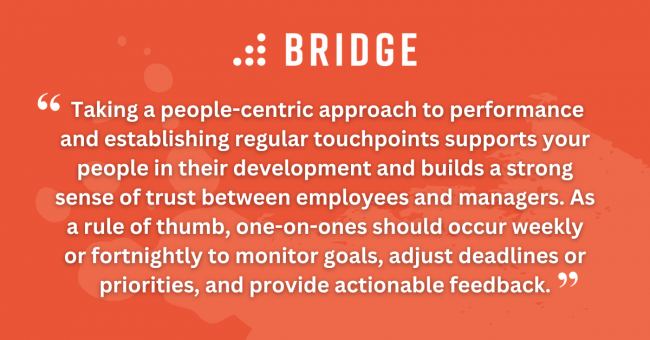
3) A Culture of Continuous Communication and Feedback
A performance management plan should outline best practices for monitoring progress and promote a culture of continuous support and communication. Take advantage of techniques including:
Encouraging Regular Manager-Employee One-on-Ones
Engaging in meaningful conversations is a top priority for any employee, and as Gallup research illustrates, when managers make check-ins a priority, employee engagement and performance increase as a result.
Taking a people-centric approach to performance and establishing regular touchpoints supports your people in their development and builds a strong sense of trust between employees and managers.
As a rule of thumb, one-on-ones should occur weekly or fortnightly to monitor goals, adjust deadlines or priorities, and provide actionable feedback based on performance.
It's also helpful for both parties to share an agenda they can reference and discuss during catch-ups. This could include some of the following:
- Accomplishments and wins
- Roadblocks and challenges
- Status updates
- Goal progress
- Relevant business updates
ADDITIONAL INSIGHTS | ‘One-on-One Meetings: How the Personal Touch Improves Workplace Performance’
Promoting Ongoing Feedback
The dynamic between managers and direct reports is an important one, and it's in those check-ins and feedback conversations that employees gain the support to develop and grow.
However, an impactful feedback culture is built on fast and frequent feedback from individuals across your organization, including:
- Peers and teammates
- Managers and leaders
- Coaches and mentors
With a variety of different perspectives, you gain a deeper understanding of employee competency based on factors such as attitude and on-the-job performance that line managers might not see in the day-to-day. Providing ongoing skills feedback can offer greater clarity and transparency into the work your people do and lead to more targeted and relevant learning.
FEEDBACK BEST PRACTICES | ‘4 Reasons to Implement Continuous Feedback (And a Few Tips on Making It Happen!)’
Enabling Personalized Training and Development
Proactive performance management is all about giving your people the tools to be the best they can be—and this requires a holistic approach to talent management. With a view into your organization's existing roles and skills, you can see how your people leverage these skills and connect employees to the opportunities that enable performance and growth.
As research shows, there's a strong link between employee development and performance. Organizations investing in their people through skills development are over four times as likely to outperform competitors and 1.3 times more likely to develop high-performing employees.
An intuitive performance management platform, paired with an upskilling solution, can combine skills and performance data to recommend training programs, connect your people with knowledgeable mentors and coaches, and list projects and stretch assignments. Put together, these features can help employees develop and accomplish their goals. This information can also inform feedback conversations, one-on-ones, and talent reviews.
RELATED READING | ‘Unlock AI-Powered Upskilling and Motivate Employee Development With Bridge’
4) Regular Reviews and Performance Evaluations
Periodic reviews equip managers and employees with a more accurate picture of performance. Aim for these conversations to take place quarterly or bi-annually and consider:
Sharing a Transparent Performance Framework
The level of communication between employees and managers can influence the effectiveness of a performance review. When done well, frequent feedback and check-ins give managers a clear idea about how employees have performed throughout the year.
FIND OUT MORE | ‘Why Performance Reviews Shouldn’t Be a Once-a-Year Deal’
Increasing Visibility With Data
An impersonal and inflexible checkbox approach toward performance is unlikely to be an unbiased and fair one. Instead, reviews should allow for an element of customization to reflect the value of your people's efforts and showcase their outputs.
Pulling relevant data and reports such as skills reviews, assessment scores, and job-specific results like customer feedback from your analytics tool can enhance reviews and create a positive and empowering experience for employees.
In addition, incorporating reviews from those who work closely with employees and frequently interact with them can highlight some of their key achievements.
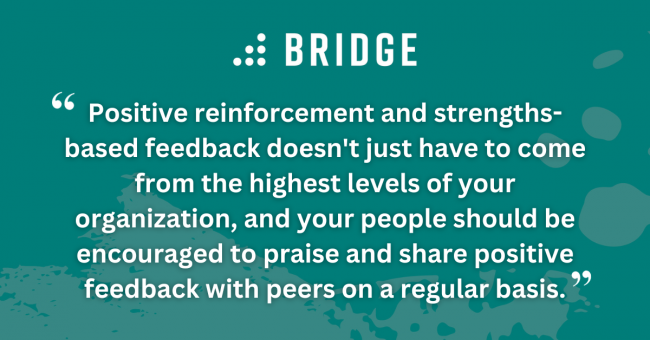
5) Talent Reviews
Talent reviews can work alongside performance conversations, giving you visibility of talent at a macro level, informing development and succession planning activities, and motivating your people through rewards.
LOOKING FOR A PLATFORM TO TRANSFORM YOUR PROCESSES? | ‘Performance Fundamentals: 4 Benefits of Embracing Performance Management Systems’
Calibrating on Talent Reviews
It's good practice for managers to review the talent that exists within their teams on a quarterly or semi-annual basis based on their potential and performance.
Assessing behaviors and competencies alongside other managers and referencing performance data helps to spot development opportunities and identify high performers.
Factors such as the potential for growth and alignment with the company's mission all portray an accurate and rounded view of employees, which can then be used to adjust goals and development activities.
9-BOX OR SINGLE AXIS? READ THIS TO LEARN MORE! | ‘Rethinking the 9 Box Talent Review’
Targeting Succession Planning Efforts for the Future
Connecting performance management efforts with succession planning initiatives helps you to spot your high performers and those with the skills to advance into more senior roles.
By identifying those with business-critical skills (and those who display the behaviors necessary to step into leadership roles), you can target development activities and strengthen the pipeline of talent within your company.
YOUR STEP-BY-STEP SUCCESSION PROCESS | ‘Succession Planning: A 6-Step Strategy for Success’
Tying High Performance Into Recognition and Rewards
Establish and share a rewards system that aligns with performance goals and recognizes your people for their positive contributions. This way, people know how their efforts feed into organizational success.
Positive reinforcement and strengths-based feedback doesn't just have to come from the highest levels of your organization, and your people should be encouraged to praise and share positive feedback with peers on a regular basis.
Supercharge Your Performance Management Strategies With Bridge
Bridge Perform helps organizations develop their employees with performance conversations, career development plans, 360 skills feedback, talent reviews, and 1on1 agendas. In one unified experience, it’s easier than ever to align goals, identify skills coverage, get continuous feedback, and make informed talent decisions. Bridge has helped thousands of organizations drive growth through engaged and aligned teams.
